Consumer expectations are constantly evolving when it comes to interacting with brands and getting customer service. While offering just email or phone support was once more than enough, today’s reality is completely different. In fact, according to Salesforce research, on average, B2B buyers engage with companies across ten channels, and B2C consumers typically use eight. And the channel choice depends on where they are and what they’re doing.
Moreover, when engaging with brands across different channels, consumers expect connected experiences without having to re-explain their issue to different customer service reps whenever they switch channels. Yet, unfortunately, many companies still struggle to deliver seamless omnichannel experiences.
Let’s take a closer look at what omnichannel customer service really is, why consumers have come to expect it, and how you can implement omnichannel customer service in your business to improve CX and meet your customers’ expectations.
What is Omnichannel Customer Service?
Omnichannel customer service involves supporting customers through multiple communication channels while delivering a seamless experience across all of them. What does it look like in practice? Here’s a quick example. A customer may initiate a conversation with a company on social media or through live chat and then call the next day. An agent who answers the call will have the full context of the previous interaction so they can pick up exactly where the previous conversation ended.
The outcome – the entire customer journey is seamless. There are no information gaps, the customer doesn’t have to repeat their query to another agent, and the agent doesn’t have to ask unnecessary questions to get the context. It creates a more satisfactory and hassle-free experience for both customers and customer service reps.
Omnichannel vs. Multichannel Customer Service: Key Differences
The concept of omnichannel customer service has been around for over a decade now. Surprisingly, though, many businesses still struggle to differentiate between multichannel and omnichannel support. While both approaches involve using more than one customer service channel to support customers, there’s a significant difference between the two.
Multichannel Customer Service
With a multichannel approach, customers are given the option to use several channels to reach out to a brand based on their preferences. But these channels are all managed in isolation, with no centralized access to customer data and the history of previous interactions across all of them. As a result, whenever a customer starts an interaction on one channel and then switches to another channel, agents lack context, and the customer needs to re-explain their problem all over again from the start. Not only is it less efficient and more time-consuming – but it also creates a more frustrating experience and leaves the customer dissatisfied.
Omnichannel Customer Service
With an omnichannel approach, on the other hand, a conversation on one channel can be continued on another channel exactly from where it ended earlier. Agents manage customer interactions across multiple channels from a single omnichannel contact center platform. Most importantly, agents have instant access to all the available customer data and the outcomes of previous interactions, regardless of where they happened – and they can easily pick up on any conversation, delivering a seamless CX.
Here are the key differences summarized:
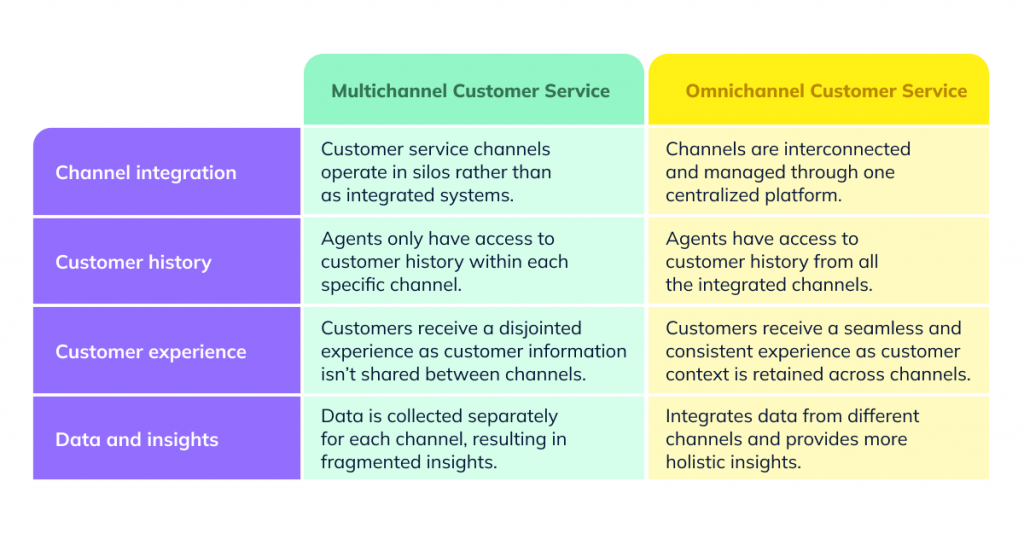
Why Does Omnichannel Service Matter to Consumers and Businesses?
Consumers highly expect omnichannel experiences
Today’s consumers are no longer satisfied with businesses offering only one or two service channels, especially if those are not their preferred ones. They want to reach out to brands on a variety of channels depending on what suits them in the moment, whether it’s social media, live chat, or SMS. A Salesforce study revealed that 71% of customers prefer using different channels based on the context. And what’s more:
- 79% of customers expect consistent interactions across departments;
- 56% often have to repeat or re-explain information to different representatives;
- 70% expect all company representatives to have the same information about them;
- 55% say it generally feels like they’re communicating with separate departments, not one company.
Not only do these stats prove that consumers highly expect seamless omnichannel experiences, but also show that many businesses still fail to meet consumers’ expectations.
Omnichannel customer service is convenient for consumers
According to McKinsey research, more than half of customers engage with three to five channels during each journey they take toward resolving an issue or making a purchase. With truly omnichannel customer service, consumers are empowered to contact businesses through the channels they are already most comfortable with. On top of that, regardless of what channel they choose or how many channels they switch in the course of a single interaction, they will get a seamless experience without having to re-explain their issue multiple times.
Businesses can increase customer satisfaction and improve loyalty
With instant access to customer data and the history of previous interactions and purchases, customer service agents can deliver more tailored and personalized experiences and resolve issues faster, resulting in reduced Average Handle Times (AHT) and increased Customer Satisfaction Score (CSAT). And considering that nearly 90% of buyers say the experience a company provides matters as much as its products or services, implementing an omnichannel service strategy ensures you can better meet your customers’ expectations and helps improve customer loyalty.
Omnichannel customer service creates a better experience for agents
By delivering omnichannel customer support, you can improve the experience for your agents, too. Omnichannel software consolidates multiple support channels in a single platform, while customer data is centralized and synced across all of them. That eliminates the need for your customer service team to constantly switch between different platforms and ask repetitive questions that frustrate customers. As a result, customers’ issues get resolved faster and more efficiently, while both agents and customers get a more seamless experience.
How to Implement an Omnichannel Customer Service Strategy
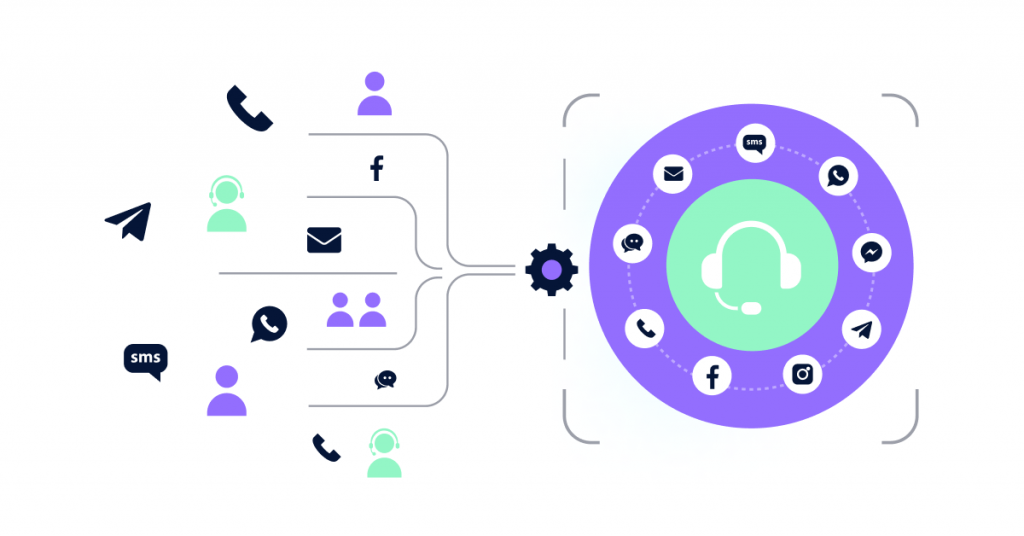
Choose a solid omnichannel customer service software solution
The first and the most fundamental step to take in implementing an omnichannel customer service strategy is selecting omnichannel customer service software. With the right platform, you’ll be able to add as many support channels as you need and manage customer interactions across all of them from a single system. VoiceSpin’s AI Messaging is an excellent example of an omnichannel customer service software platform.
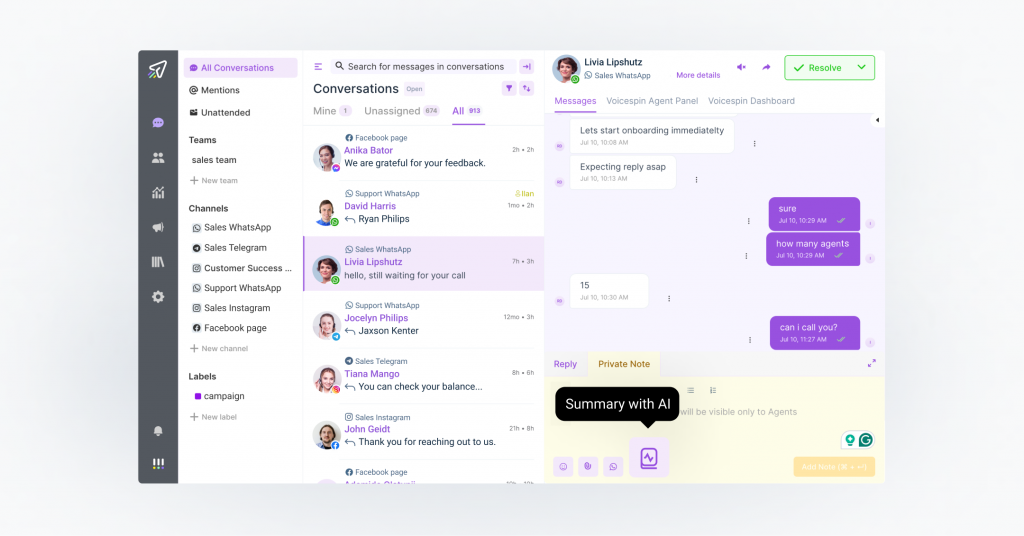
- Unify multiple channels under one roof: Integrate email, live chat, SMS, Facebook, Instagram, WhatsApp, and other digital communication channels or create custom channels through the API and empower your customers to reach out to you through their preferred method.
- Manage interactions from an omnichannel inbox: Organize your conversations across channels with labels and manage them all from a single unified omnichannel inbox, with instant access to customer data and previous interaction history, giving agents a holistic view of each customer’s journey.
- Speed up responses with AI reply suggestions: Enable your agents to respond faster to common questions with canned messages and AI-generated reply suggestions, automate answers to repetitive inquiries, reduce handle times, and save your reps time and effort.
- Streamline operations with automation: Set up rules to automate workflows and processes, such as adding labels to conversations and assigning them to relevant teams, and streamline your customer support operations.
- Measure performance with reports: Track your most important metrics like resolved issues, response times, resolution times, and CSAT scores and browse specific reports by agents, teams, labels, or channels for more detailed performance insights.
- Get an overview of each conversation with AI summaries: Stay on top of the quality of customer interactions with the AI-generated conversation summary feature and assess your team’s performance without having to read the entire transcript of every conversation.
- Integrate self-service AI chatbots: Set up and train an AI chatbot to deliver 24/7 customer support and enable your customers to find information and resolve basic issues on their own even when your customer support reps are not immediately available to respond.
Offer support on channels your customers prefer to use
When evaluating what customer support channels you should integrate to implement your omnichannel support strategy, customer preferences should be your primary deciding factor. One of the easiest and quickest ways to better understand your customer behavior and expectations when it comes to interacting with your business is to simply ask them about their preferences through surveys or feedback forms. Here are some of the questions you can ask your customers:
- Which communication channels do you prefer to use to get customer support?
- Which support channel do you find the most effective for resolving your issues?
- Which support channel do you find the most convenient to use?
- Would you like us to add new customer support channels? If yes, which ones?
Moreover, while taking into account the expectations and channel preferences of your existing customers, you should also think about your target audience in general and consider adding new channels that your potential customers across different demographics would potentially prefer to use. For example, you might want to add one or more of these digital channels:
Live Chat
Live chat is known to be one of the fastest-growing digital support channels. Consumers mostly love it because of the convenience it provides, allowing them to get immediate support from a human agent without having to wait on hold. According to a Salesforce study, 72% of consumers prefer using online chat to engage with companies. At the same time, research from Zendesk shows that live chat has the second-highest customer satisfaction rate (85%). And among millennials, in particular, live chat is the most preferred customer support channel.
Chatbots
The increasing usage of AI in customer service and the rising demand for self-service support have recently brought chatbots to the forefront of customer service operations. Based on the stats published by Outgrow, 74% of customers would choose a chatbot over a human rep to look for answers to simple questions – and if the alternative were to wait 15 minutes for an answer, 62% of consumers would rather talk to a chatbot than a human agent. No wonder Gartner predicts that by 2027, chatbots will become the primary customer service channel for nearly a quarter of organizations.
Social Media
A recent Salesforce study found that 64% of consumers prefer using social media platforms to interact with brands. Most importantly, responding to comments, mentions, and DMs on social media isn’t just another way to support customers and engage with them, it can also impact customer loyalty. Data from SproutSocial shows that 63% of consumers agree their loyalty to a brand is significantly influenced by the quality of customer service they provide on social media.
First and foremost, with almost 3 billion unique users, WhatsApp is the most popular instant messaging app in the world. According to stats published by Hootsuite, 80% of adults say messaging is an easy way to communicate with businesses – and 175 million people message businesses on WhatsApp every day. Moreover, based on a case study by Tyntec on GlobeAir, WhatsApp Business can speed up customer service by 225% and increase sales by 27%.
Recommended reading: How to Choose the Right Customer Service Channels for Your Business.
Meet customer expectations for response times across channels
When offering support across various channels, it’s also essential to make sure you are actually meeting your customers’ expectations in terms of response times. And those may significantly differ across channels. Here’s what various studies suggest:
- Live chat support users naturally expect you to respond almost immediately. Based on a HubSpot study, 66% of consumers are expecting a response from your customer service team on live chat within five minutes.
- When it comes to customers’ expectations for response times on social media platforms, most consumers (69%) want brands to respond within 24 hours, and 16% want a response within minutes, according to data from SproutSocial.
- A study from Toister Performance Solutions, sponsored by SupperOffice, found that while some customers are still okay with a 24-hour response time to customer emails, many want to hear from you much faster. Responding to an email in an hour will meet the expectations of 88% of consumers surveyed.
Build comprehensive self-help resources
While it’s important to provide your customers with multiple customer support channels they can use to reach out to your business, offering self-service resources can also be a valuable element of your omnichannel customer service strategy. And numerous studies prove again and again that self-service support is becoming increasingly preferred by consumers. According to a report from Higher Logic, 79% of consumers say they expect organizations to provide self-service support options to help customers find answers without having to contact customer support. The same report also revealed that:
- 84% of consumers try to solve issues on their own before they contact support;
- 77% say that they view organizations more positively if they offer self-service options;
- 92% say they would use a knowledge base for self-service support if it was available;
- 83% say they would use an online community for self-service support if it was available;
- 62% say that an active and visible support community increases the likelihood of making a purchase.
Moreover, based on a report from Gartner, 28% percent of customers across all age groups reported they are most likely to quit trying to resolve a problem with a product or service, rather than reach out to an agent for help, if they cannot find a solution on their own online.
Your self-service options may include anything from knowledge bases and FAQs to chatbots and customer communities. Not only can they make it easier for your customers to find answers to common questions and resolve issues independently, enabling you to provide 24/7 support even when your reps are offline. Providing self-help resources to your customers can also eventually reduce your overall support ticket volume.
Gauge customer feedback to improve your service efficiency
Customer feedback has always been a valuable source of information for businesses. While you can measure the effectiveness of your omnichannel customer support by tracking critical metrics and KPIs like First Response Time, First Contact Resolution rate (FCR), Average Handle Times, and channel-specific metrics, you can get much deeper insights and more meaningful feedback from tracking customer satisfaction metrics through customer feedback surveys. These include:
✓ Customer Satisfaction Score (CSAT): CSAT helps you understand how a customer feels after interacting with your customer service representative. You can measure CSAT through post-interaction surveys that may include different types of questions, such as:
- On a scale of 1-5, how satisfied are you with the provided resolution?
- How would you rate the level of customer service you received today? (Poor /Neutral/ Excellent)
✓ Customer Effort Score (CES): CES measures the effort a customer takes to get their question answered or issue resolved. It helps you better understand how easy it is for your customers to interact with your businesses and receive customer support. Here are some CES question examples:
- On a scale of 1-5, how easy was it to resolve your issue today?
- How much effort did you put into resolving your issue? (Low effort/ Neutral/ High effort)
✓ Net Promoter Score (NPS): NPS measures a customer’s willingness to recommend your company to others based on their experience with your business. Unlike CSAT and CES that capture customer sentiment at any particular moment of the customer journey, NPS helps you assess overall customer loyalty:
- On a scale of 1-10, how likely are you to recommend our company to your friends or family?
- On a scale of 1-10, how likely are you to recommend our company to your friend or colleague based on your interaction with our support team today?
The best part about leveraging customer feedback surveys is that you can also include open-ended questions (like ‘What can our customer support team do better next time?’ or ‘How do you think we could improve our customer service?’) and get more detailed feedback from your customers telling you what exactly you can improve in your service strategy to make their experience more efficient, seamless, and enjoyable.
Deliver Omnichannel CX with VoiceSpin AI Messaging
With an omnichannel customer service strategy, you can create a seamless customer journey regardless of the channels customers choose to use to connect with your brand, increase customer satisfaction, and ultimately improve loyalty. VoiceSpin’s AI Messaging offers everything you need to implement omnichannel customer service, support your customers across multiple channels, and conveniently manage them all from a single omnichannel inbox.
Book a demo call with one of our sales reps and see VoiceSpin’s AI Messaging omnichannel communication platform in action.


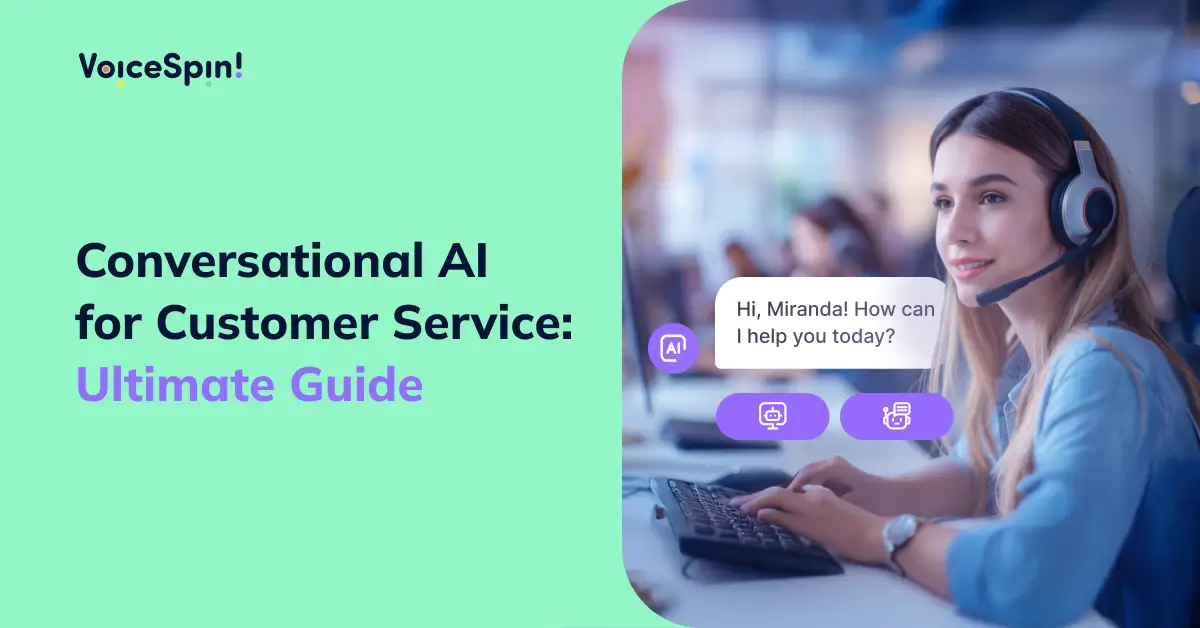
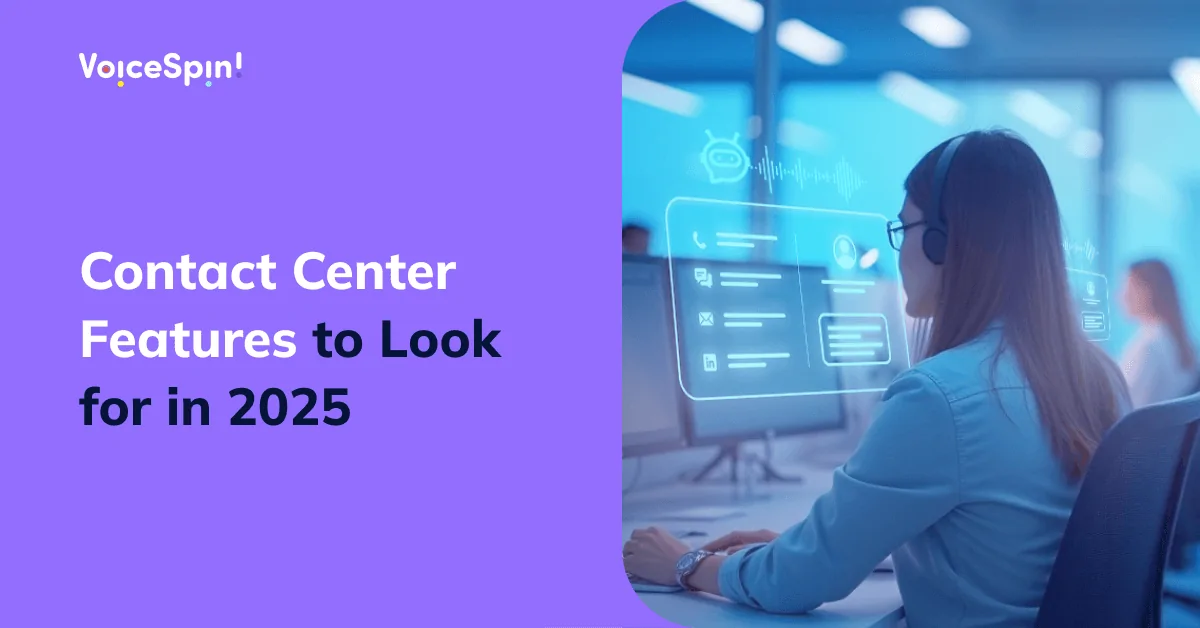

 +18889082995
+18889082995
 +442036084160
+442036084160
 +97237237006
+97237237006